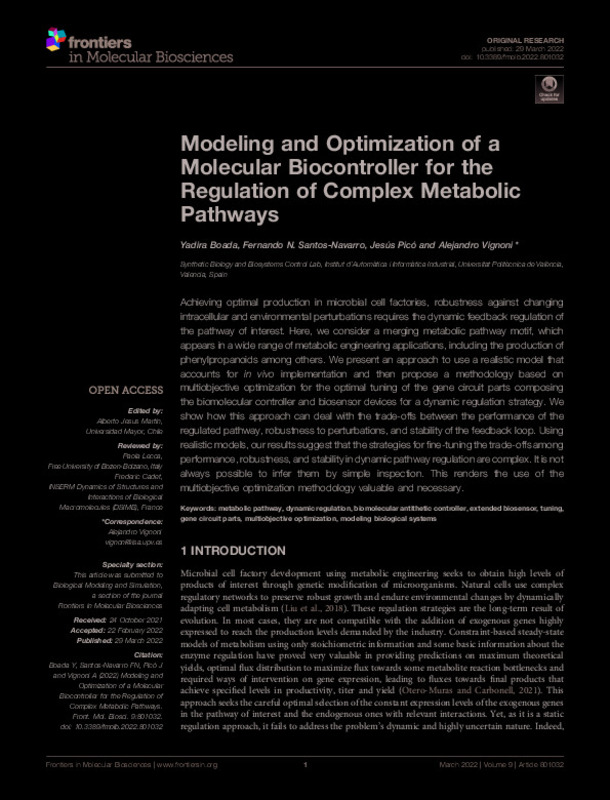JavaScript is disabled for your browser. Some features of this site may not work without it.
Buscar en RiuNet
Listar
Mi cuenta
Estadísticas
Ayuda RiuNet
Admin. UPV
Modeling and Optimization of a Molecular Biocontroller for the Regulation of Complex Metabolic Pathways
Mostrar el registro sencillo del ítem
Ficheros en el ítem
| dc.contributor.author | Boada-Acosta, Yadira Fernanda
|
es_ES |
| dc.contributor.author | Santos-Navarro, Fernando Nóbel
|
es_ES |
| dc.contributor.author | Picó, Jesús
|
es_ES |
| dc.contributor.author | Vignoni, Alejandro
|
es_ES |
| dc.date.accessioned | 2023-06-27T18:00:58Z | |
| dc.date.available | 2023-06-27T18:00:58Z | |
| dc.date.issued | 2022-03-29 | es_ES |
| dc.identifier.uri | http://hdl.handle.net/10251/194571 | |
| dc.description.abstract | [EN] Achieving optimal production in microbial cell factories, robustness against changing intracellular and environmental perturbations requires the dynamic feedback regulation of the pathway of interest. Here, we consider a merging metabolic pathway motif, which appears in a wide range of metabolic engineering applications, including the production of phenylpropanoids among others. We present an approach to use a realistic model that accounts for in vivo implementation and then propose a methodology based on multiobjective optimization for the optimal tuning of the gene circuit parts composing the biomolecular controller and biosensor devices for a dynamic regulation strategy. We show how this approach can deal with the trade-offs between the performance of the regulated pathway, robustness to perturbations, and stability of the feedback loop. Using realistic models, our results suggest that the strategies for fine-tuning the trade-offs among performance, robustness, and stability in dynamic pathway regulation are complex. It is not always possible to infer them by simple inspection. This renders the use of the multiobjective optimization methodology valuable and necessary. | es_ES |
| dc.description.sponsorship | This research was funded by MCIN/AEI/10.13039/501100011033 grant number PID 2020-117271RB-C21. YB thanks to Universitat Politècnica de València (Grant PAID-10-21 Acceso al Sistema Español de Ciencia e Innovación), and Secretaría de Educación Superior, Ciencia, Tecnología e Innovación-Ecuador (Scholarship Convocatoria Abierta 2011). FS-N is grateful to grant PAID-01-2017 from Universitat Politècnica de València. | es_ES |
| dc.language | Inglés | es_ES |
| dc.publisher | Frontiers Media SA | es_ES |
| dc.relation.ispartof | Frontiers in Molecular Biosciences | es_ES |
| dc.rights | Reconocimiento (by) | es_ES |
| dc.subject | Metabolic pathway | es_ES |
| dc.subject | Dynamic regulation | es_ES |
| dc.subject | Biomolecular antithetic controller | es_ES |
| dc.subject | Extended biosensor | es_ES |
| dc.subject | Tuning | es_ES |
| dc.subject | Gene circuit parts | es_ES |
| dc.subject | Multiobjective optimization | es_ES |
| dc.subject | Modeling biological systems | es_ES |
| dc.subject.classification | INGENIERIA DE SISTEMAS Y AUTOMATICA | es_ES |
| dc.title | Modeling and Optimization of a Molecular Biocontroller for the Regulation of Complex Metabolic Pathways | es_ES |
| dc.type | Artículo | es_ES |
| dc.identifier.doi | 10.3389/fmolb.2022.801032 | es_ES |
| dc.relation.projectID | info:eu-repo/grantAgreement/AEI/Plan Estatal de Investigación Científica y Técnica y de Innovación 2017-2020/PID2020-117271RB-C21/ES/REGULACION DINAMICA MULTI-ESCALA EN INGENIERIA METABOLICA: CONTROL REALIMENTADO Y CICLO DBTL AUTOMATIZADO / | es_ES |
| dc.relation.projectID | info:eu-repo/grantAgreement/UPV//PAID-10-21/ | es_ES |
| dc.relation.projectID | info:eu-repo/grantAgreement/UPV//PAID-01-17/ | es_ES |
| dc.rights.accessRights | Abierto | es_ES |
| dc.contributor.affiliation | Universitat Politècnica de València. Escuela Técnica Superior de Ingeniería del Diseño - Escola Tècnica Superior d'Enginyeria del Disseny | es_ES |
| dc.contributor.affiliation | Universitat Politècnica de València. Escuela Técnica Superior de Ingenieros Industriales - Escola Tècnica Superior d'Enginyers Industrials | es_ES |
| dc.description.bibliographicCitation | Boada-Acosta, YF.; Santos-Navarro, FN.; Picó, J.; Vignoni, A. (2022). Modeling and Optimization of a Molecular Biocontroller for the Regulation of Complex Metabolic Pathways. Frontiers in Molecular Biosciences. 9:1-14. https://doi.org/10.3389/fmolb.2022.801032 | es_ES |
| dc.description.accrualMethod | S | es_ES |
| dc.relation.publisherversion | https://doi.org/10.3389/fmolb.2022.801032 | es_ES |
| dc.description.upvformatpinicio | 1 | es_ES |
| dc.description.upvformatpfin | 14 | es_ES |
| dc.type.version | info:eu-repo/semantics/publishedVersion | es_ES |
| dc.description.volume | 9 | es_ES |
| dc.identifier.eissn | 2296-889X | es_ES |
| dc.identifier.pmid | 35425808 | es_ES |
| dc.identifier.pmcid | PMC9001882 | es_ES |
| dc.relation.pasarela | S\481167 | es_ES |
| dc.contributor.funder | AGENCIA ESTATAL DE INVESTIGACION | es_ES |
| dc.contributor.funder | Universitat Politècnica de València | es_ES |
| dc.contributor.funder | Secretaría de Educación Superior, Ciencia, Tecnología e Innovación, Ecuador | es_ES |
| upv.costeAPC | 2793,78 | es_ES |








